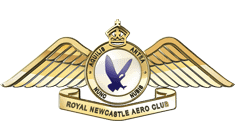
Aircraft from Disposals were released to the Club, the first of these being five Avro Cadets bi-planes. Once more Club aircraft could be seen in the circuit area at Broadmeadow and the scene was set for a post-war boom in flying operations.

Aircraft from Disposals were released to the Club, the first of these being five Avro Cadets bi-planes. Once more Club aircraft could be seen in the circuit area at Broadmeadow and the scene was set for a post-war boom in flying operations.
By 1946 the Club’s fleet had grown to 20 aircraft, the Avro cadets and Tiger Moths had been joined by 2 Wackett trainers and 2 DH-84 twin engined Dragons. These aircraft were painted in the Club’s pre-war colours of Maroon fuselage and Silver wings.
The Club extended its country operations to Tamworth, Narrabri, Inverell, Armidale, Casino, Grafton, Coffs Harbour, Kempsey, Tenterfield, Orange, Murwillumbah and Taree.
The Club by now was expanding very rapidly as new aircraft joined the fleet. During 1947 the Club aircraft numbered 34 tiger Moths, 7 Avro cadets, 1 Hornet Moth, 2 Wackett trainers, and 2 Dragons.
In 1948 the Club took delivery of its first Auster Autocrat, VH-KSC, 3 more of these modern cabin aircraft were to eventually be taken on charge. Also in 1948 a twin engined Miles Gemini, VH-BJZ, and 2 snappy Ryans, VH-AHF and AHE, joined the other aircraft at Broadmeadow.
Aero Club members then acquired land at Rutherford, near Maitland, and a Maitland Aero Club was formed under the auspices of Newcastle Aero Club. 1949 was also another landmark year when District Park aerodrome installed a VHF ground station with a radius of 40 miles. All the Club’s cabin aircraft were fitted with two-way radio.

